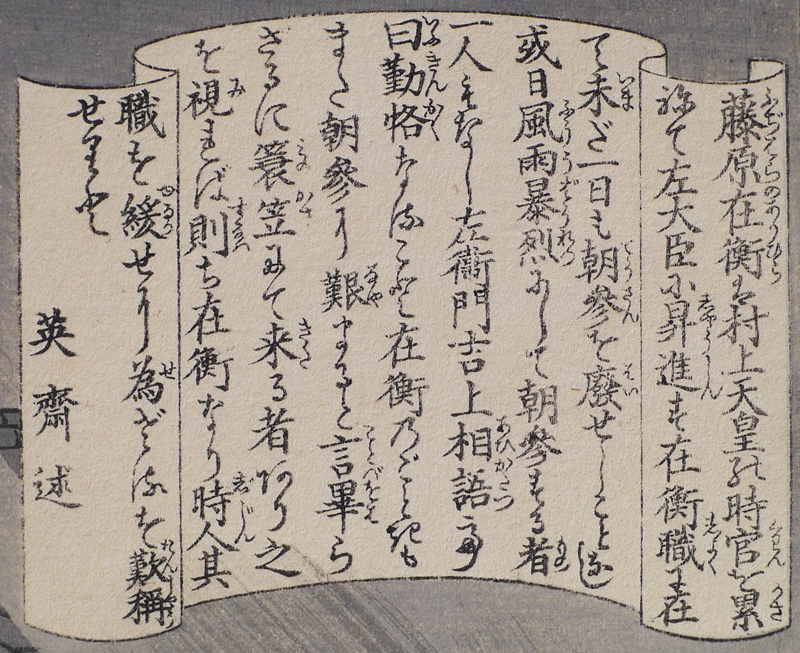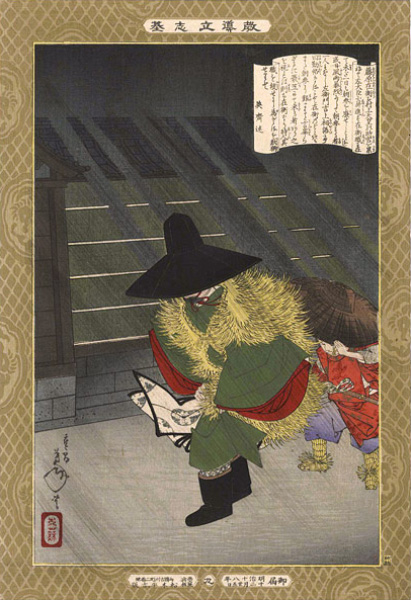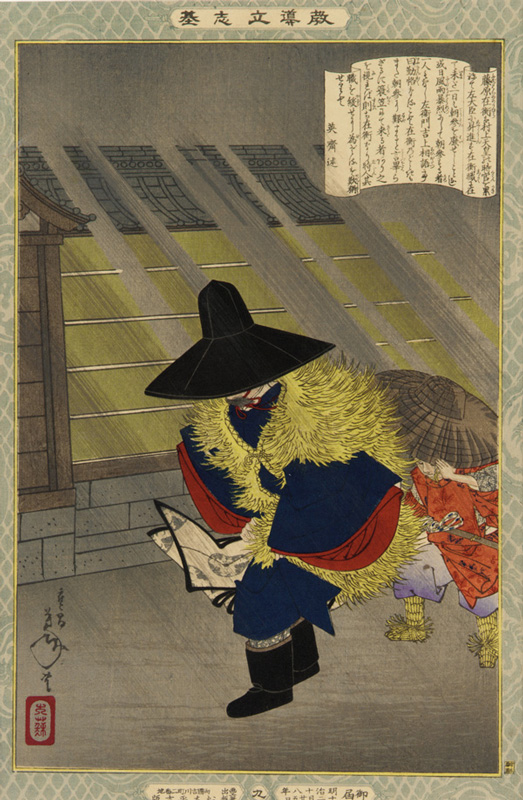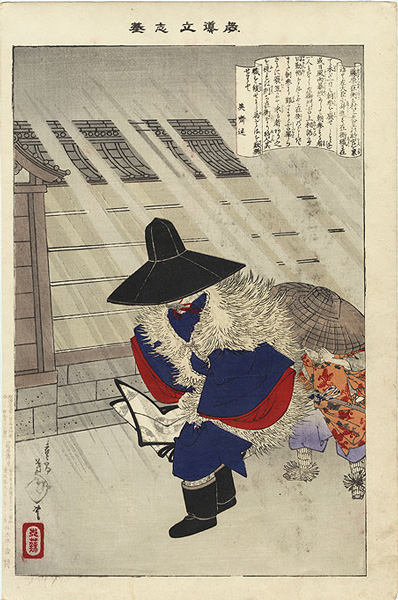About This Print
Print number 91 (九) in the series Instructive Models of Lofty Ambition picturing Minister of the State Fujiwara no Arihira (891-970) and his assistant, in service to Emperor Murakami 村上天皇 (926-967), making their way through a terrible rainstorm to the palace.It is told that Arihira never missed a day of work.
1 The print numbers were sometimes inadvertently omitted as they were reprinted, as in the case of this print; some prints in the series were never assigned numbers and a few of the same numbers appeared on different prints.
Transcription of Scroll
Source: with thanks to Yajifun http://yajifun.tumblr.com/click on image to enlarge
9 Fujiwara no Arihira 藤原在衡
教導立志基 九 藤原在衡 月岡芳年 1885年12月25日
Transcription:
“藤原在衡は?村上天皇の時 官を累(かさ)ねて左大臣に昇進す 在衡 職に在て未だ一日も朝参を廃せしことなし或日風雨暴烈にして朝参する者一人もなし 左衛門吉上相語て曰 勤格なること在衡のごときもまだ朝参に難する?と言畢らざるに蓑笠にて来る者あり之を視れば則ち在衡なり 時人其職を緩せに為ざるを歎稱(歎称)せりと 英斎 述”
About The Series "Kyōdō risshi no motoi"
Notes:1. This series is variously translated as "Instructive Models of Lofty Ambition," "Foundations of Learning and Achievement," "Foundation of Instruction and Perseverance," "Self-Made Men Worthy of Emulation," "Paragons of Instruction and Success," "Moral of Success," "Examples of Self-Made Leaders," and "Instruction in the Fundamentals of Success." The title in Japanese is sometimes seen as "Kyōdō risshiki or "Kyōdō risshi no moto," in addition to the most commonly seen transliteration of "Kyōdō risshi no motoi".2. For a complete listing of all the prints in the series and additional information please see the article on this site titled Instructive Models of Lofty Ambition.
This series ran between October 1885 and November 1890 and featured a long list of heroes and heroines, from antiquity to contemporary times, who were regarded as standards of moral leadership and self-realization.
Source: Kiyochika Artist of Meiji Japan, Henry D. Smith II, Santa Barbara Museum of Art, 1988, p. 74-75; original research and as footnoted.
This series of 58 prints,1 plus a table of contents sheet (目録), were originally published between October 1885 and November 1890 by the Tokyo publisher Matsuki Heikichi 松木平吉.2 The table of contents sheet issued by the publisher states that "fifty prints make up the complete set (五十番揃)". Three prints not in the initial release were added over the five year publication period, as were five redesigns of original prints, eventually increasing the total print count to 58. The seven artists contributing prints were Kobayashi Kiyochika (1847-1915) [20 prints], Mizuno Toshikata (1866-1908) [16 prints], Inoue Tankei (Yasuji) (1864-1889) [13 prints], Taiso (Tsukioka) Yoshitoshi (1839-1892) [5 prints], Yōshū Chikanobu (1838-1912) [2 prints], Toyohara Kunichika (1835–1900) [1 print], and Hachisuka (Utagawa) Kuniaki II (1835-1888) [1 print]. All the artists, with the exception of Yōshū Chikanobu, are listed in the top scroll of the table of contents sheet. Various colors (including blue, blue/green, and tan/brown) were used for the decorative border, and in 1902 the series was re-issued by Matsuki without borders.
Brief texts contained within a scroll-like cartouche appearing on each print provide historical details. The scroll composer's name is given at the end of the scroll text. The “lofty ambition” of the title is a Confucian concept, originally from Mencius, meaning “righteous determination that would inspire others.” The market for the series probably included former samurai, ambitious youth, and conservative intellectuals.
"[W]hen it was completed in 1890 the publisher was singled out for special recognition by the government for having sponsored such noble subject matter."3
This series ran between October 1885 and November 1890 and featured a long list of heroes and heroines, from antiquity to contemporary times, who were regarded as standards of moral leadership and self-realization.
Source: Kiyochika Artist of Meiji Japan, Henry D. Smith II, Santa Barbara Museum of Art, 1988, p. 74-75; original research and as footnoted.
This series of 58 prints,1 plus a table of contents sheet (目録), were originally published between October 1885 and November 1890 by the Tokyo publisher Matsuki Heikichi 松木平吉.2 The table of contents sheet issued by the publisher states that "fifty prints make up the complete set (五十番揃)". Three prints not in the initial release were added over the five year publication period, as were five redesigns of original prints, eventually increasing the total print count to 58. The seven artists contributing prints were Kobayashi Kiyochika (1847-1915) [20 prints], Mizuno Toshikata (1866-1908) [16 prints], Inoue Tankei (Yasuji) (1864-1889) [13 prints], Taiso (Tsukioka) Yoshitoshi (1839-1892) [5 prints], Yōshū Chikanobu (1838-1912) [2 prints], Toyohara Kunichika (1835–1900) [1 print], and Hachisuka (Utagawa) Kuniaki II (1835-1888) [1 print]. All the artists, with the exception of Yōshū Chikanobu, are listed in the top scroll of the table of contents sheet. Various colors (including blue, blue/green, and tan/brown) were used for the decorative border, and in 1902 the series was re-issued by Matsuki without borders.
This series of 58 prints,1 plus a table of contents sheet (目録), were originally published between October 1885 and November 1890 by the Tokyo publisher Matsuki Heikichi 松木平吉.2 The table of contents sheet issued by the publisher states that "fifty prints make up the complete set (五十番揃)". Three prints not in the initial release were added over the five year publication period, as were five redesigns of original prints, eventually increasing the total print count to 58. The seven artists contributing prints were Kobayashi Kiyochika (1847-1915) [20 prints], Mizuno Toshikata (1866-1908) [16 prints], Inoue Tankei (Yasuji) (1864-1889) [13 prints], Taiso (Tsukioka) Yoshitoshi (1839-1892) [5 prints], Yōshū Chikanobu (1838-1912) [2 prints], Toyohara Kunichika (1835–1900) [1 print], and Hachisuka (Utagawa) Kuniaki II (1835-1888) [1 print]. All the artists, with the exception of Yōshū Chikanobu, are listed in the top scroll of the table of contents sheet. Various colors (including blue, blue/green, and tan/brown) were used for the decorative border, and in 1902 the series was re-issued by Matsuki without borders.
Brief texts contained within a scroll-like cartouche appearing on each print provide historical details. The scroll composer's name is given at the end of the scroll text. The “lofty ambition” of the title is a Confucian concept, originally from Mencius, meaning “righteous determination that would inspire others.” The market for the series probably included former samurai, ambitious youth, and conservative intellectuals.
"[W]hen it was completed in 1890 the publisher was singled out for special recognition by the government for having sponsored such noble subject matter."3
1 The Tokyo Metropolitan Library online collection shows 50 prints and a Table of Contents sheet. The Table of Contents lists the titles of 50 prints. Smith in Kiyochika Artist of Meiji Japan identified 52 prints. I have identified 58 prints from this series including five prints (Ikina, Michizane Sugiwara, Kesa Gozen, Soga Brothers and Hokiichi Hanawa) that were re-designed and re-printed, likely due to damaged or lost blocks.
2 Robert Schaap notes in Appendix II, p. 166 of Yoshitoshi, Masterpieces from the Ed Freis Collection, Chris Uhlenbeck and Amy Reigle Newland, Hotei Publishing, 2011 that the series originally appeared as newspaper supplements.
3 The World of the Meiji Print: Impressions of a New Civilization, Julia Meech-Pekarik, Weatherhill, 1986, p. 122.
1 The Tokyo Metropolitan Library online collection shows 50 prints and a Table of Contents sheet. The Table of Contents lists the titles of 50 prints. Smith in Kiyochika Artist of Meiji Japan identified 52 prints. I have identified 58 prints from this series including five prints (Ikina, Michizane Sugiwara, Kesa Gozen, Soga Brothers and Hokiichi Hanawa) that were re-designed and re-printed, likely due to damaged or lost blocks.
2 Robert Schaap notes in Appendix II, p. 166 of Yoshitoshi, Masterpieces from the Ed Freis Collection, Chris Uhlenbeck and Amy Reigle Newland, Hotei Publishing, 2011 that the series originally appeared as newspaper supplements.
3 The World of the Meiji Print: Impressions of a New Civilization, Julia Meech-Pekarik, Weatherhill, 1986, p. 122.
Print Details
| IHL Catalog | #1069 |
| Title or Description | Fujiwara [no] Arihira 藤原在衡 |
| Series | “Instructive Models of Lofty Ambition” (Kyodo risshiki 教導立志基) [note: series title also listed as 'Kyodo Risshi no Moto', ‘Kyodo risshi no motoi’, ‘Kyōdō risshi ki’ and variously translated as “Moral of success” or “Foundations of learning and achievement” or “Self-made Men Worthy of Emulation”' or “Examples of Self-made Leaders” or "Paragons of instruction and success"] |
| Artist | Tsukioka Yoshitoshi (1839-1892) |
| Signature |  |
| Seal | 大蘇 Taiso (as shown above beneath signature) |
| Publication Date | December 25, 1885 明治年十二月二十五日 |
| Publisher | Matsuki Heikichi (松木平吉) proprietor of Daikokuya [Marks: seal not shown; pub. ref. 029] click on image to enlarge (from right to left) publishing and printing date: 御届 明治十八年 十二月 廿五日 [notification delivered, Meiji 18th year 12th month 25th day] assigned number within series: blank [九 on other impressions] publisher information: 画工兼 出版 両国吉川町二番地 松木平吉 版 [artist and publisher Ryōgoku Yoshikawachō 2-banchi Matsuki Heikichi han] |
| Carver |  |
| Impression | excellent |
| Colors | excellent |
| Condition | excellent |
| Genre | ukiyo-e; rishki-e; kyōiku nishiki-e |
| Miscellaneous | scroll text by Eisai 英斎述 print number 9 (九); position 9 in the Table of Contents for the series |
| Format | vertical oban |
| H x W Paper | 14 5/8 x 9 7/8 in. (37.1 x 25.1 cm) |
| H x W Image | 12 3/8 x 8 1/4 in. (31.4 x 21 cm) area inside brocade border |
| Literature | |
| Collections This Print | The Tsubouchi Memorial Theatre Museum of Waseda University 401-0417; Tokyo Metropolitan Library 280-K32; Tokyo Digital Museum (Edo-Tokyo Museum) 96200370; Smithsonian National Museum of Asian Art S2003.8.2974 and S2003.8.2975 (olive green and light green brocade border) |
9/24/2020






